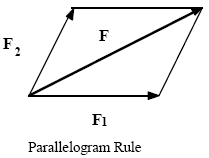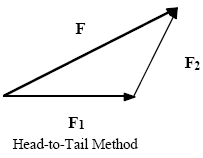Equilibrium of Forces Acting at a Point
Introduction
Addition of Forces
Forces are one of a group of quantities known as vectors, which are distinguished from regular numbers (know as scalars) by the fact that a vector has two quantities associated with it, a magnitude and a direction (related to a coordinate axes of the system you are dealing with). These properties completely characterize a vector. A vector may alternatively be described by specifying its vector components. In the case of the Cartesian coordinate system (the system we will be primarily dealing with) there are two components, the x-component and y-component. These two properties also completely characterize a vector. Vectors, and in the case of this lab, force vectors, can be represented pictorially (see Fig. 1) by an arrow pointing in the direction of action of the force, with a length proportional to the strength (magnitude) of the force.
Figure 1
Fx
and Fy
in the x and y directions of the vector F are related to the magnitude F and angle θ by:
( 1 )
Fx = F cos θ and Fy = F sin θ
( 2 )
F =
, and θ = arctan
.
 | Fx2 + Fy2 |
 |
| Fy |
| Fx |
 |
F = F
= F 1 + F
1 + F 2
2
can be found by using the parallelogram rule
illustrated in Fig. 2 or, equivalently, by the head-to-tail method illustrated in Fig. 3.
 = F
= F 1 + F
1 + F 2
2 
Figure 2

Figure 3
( 3 )
Fx = F1x + F2x, and Fy = F1y + F2y
Condition for Translational Equilibrium
An object is in translational equilibrium when the vector sum of all the forces acting on it is zero. In this experiment we shall study the translational equilibrium of a small ring acted on by several forces on an apparatus known as a force table, see Fig. 4. This apparatus enables one to cause the forces of gravity acting on several masses (F = mg) to be brought to bear on the small ring. These forces are adjusted until equilibrium of the ring is achieved. You will then add the forces analytically by adding their components and graphically by drawing the vectors and determining if they add to zero using the rules for the addition of force vectors listed above.
Figure 4
Procedure
Equilibrium with Three Forces
We shall first study the equilibrium of the small ring when there are three forces acting on it. Two of the forces(F 1 and F
1 and F 2)
2)
will be fixed and the third one  1 and F
1 and F 2)
2) F 3
3
adjusted until equilibrium is reached.
 3
3 -
1If necessary, level the force table using the small bubble level placed on the table's surface.
-
2Choose any two masses you like in the range 100-300 g, and place each mass on a weight holder. Use the electronic balance to measure each of the masses including the holder. Designate the measured masses asm1 and m2.The uncertainty of these measurements should be limited to the precision of the balance.
-
3Place the pin in the middle of the force table and place the ring over the pin. Attach two of the four pulleys provided to the force table at any position other than zero degrees. Record the value of θ1 and θ2. The uncertainty in these angles should be limited to the precision to which you can read the angles on the force table.
-
4Run two of the strings (attached to the ring) over the pulleys, and suspend the masses that you have chosen at the appropriate angles(m1 at θ1 and m2 at θ2).The tension in the two strings acts on the ring with forcesFeach with a magnitude equal to the weight of the corresponding mass and holder
 1 and F
1 and F 2, (m1g and m2g)suspended at the end of each of the strings.
2, (m1g and m2g)suspended at the end of each of the strings. -
5Pull one of the remaining strings in various directions until you locate a direction in which the ring is freed from the pin when you apply the right amount of force. Attach a third pulley at this position. Run the string over the pulley and attach a weight holder to the string. Add weights to the weight holder until the ring pulls away from the pin, so that the pin is not necessary to hold the ring in place. This last added force is the (equilibriant) force F3(m3g).It may be necessary to make minor adjustments to the angle to obtain a precise measurement. Make sure that the strings are stretched radially and the pin is at the center of the ring. Estimate the uncertainty in the equilibrant force by adjusting the mass and angle until the system is no longer in equilibrium.
Equilibrium with Four Forces
-
1Now select three masses (to provide three forces with sumFat three angles (one of them zero) and determine what fourth single mass and angle establishes equilibrium on the force table (the equilibriant force
 1 + F
1 + F 2 + F
2 + F 3) F
3) F 4).
4). -
2Record all angles, masses and their uncertainties as in Equilibrium with Three Forces.
Be sure to pledge your work, initial your data, and have your TA initial your data.
Analysis
Graphical Analysis
Make accurate diagrams on normal rectangular graph paper showing the sum of the forces acting on the ring for both parts of the experiment above.-
1Draw force diagrams to scale. For example, 5 Newtons = 1 cm. Use whatever works best to give you the greatest plotting precision.
-
2Use the head-to-tail method to find the sum of the forces graphically. Be as accurate as possible. Qualitatively verify that the sum is zero. If it is not, determine from your graph the magnitude of the deviation from zero.
Analytical Sum
Calculate the resultant force on the ring,F T = F
T = F 1 + F
1 + F 2 + F
2 + F 1,
1,
analytically for Equilibrium with Three Forces only. Choose zero degree to be the +x-axis, and 90° to be the +y-axis. The Analytical Sum section of the WebAssign question for this lab, will help facilitate the error analysis.
 T = F
T = F 1 + F
1 + F 2 + F
2 + F 1,
1, -
1Use the tables in the WebAssign question to enter the data for the forces acting on the ring. For each force, include the magnitude F, its uncertainty uF, the direction θ, and its uncertaintyuθ.The values ofuθmust be expressed in units of radians.
-
2Calculate the x- and the y-components of each of the forces together with their errors. Pay attention to the sign of each component. Include in the last row of the table the sum of the components and their error.
-
3Calculate the magnitude and the direction of the resultant forceFCompute also the uncertainty of the magnitude.
 T.
T.
Discussion
-
1Is the condition for static equilibrium satisfied for both parts of this experiment? Remember to consider the experimental uncertainty when answering this question.
-
2What do you believe is the primary source of uncertainty in this experiment?
-
3Discuss attempts that you made (or should have made) to reduce both systematic and random errors in this experiment.
